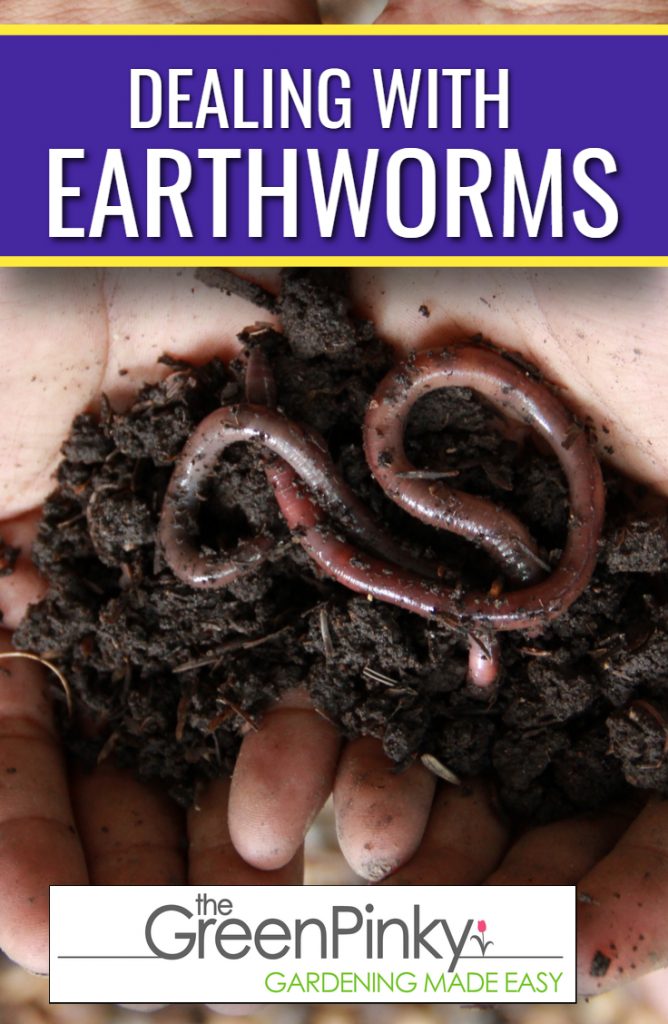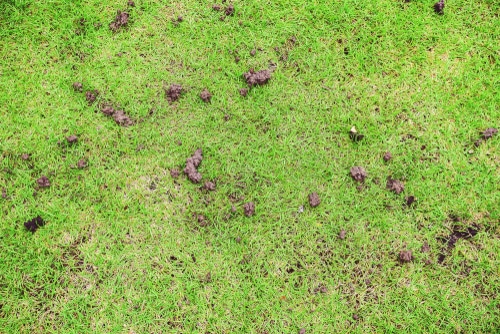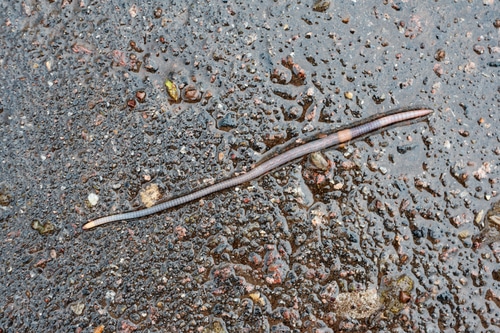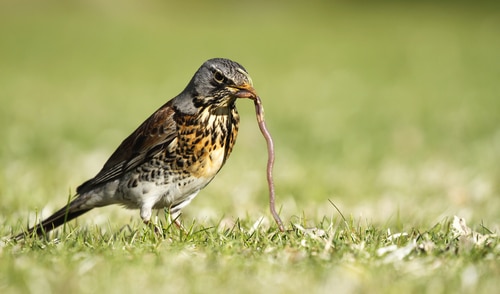How To Get Rid Of Earthworms
This post may contain affiliate sales links. Please see my full disclosure policy for details
Don't you hate the feeling when you see a bunch of insects come out after it rains? I'm thinking about one arthropod in particular. I'm sure you'll know what I'm referring to when I talk about the invertebrate animal that literally covers the sidewalks after the soil gets soaked with water. It has a purplish brown body that is slimy and slithers on the ground almost like a tiny snake. Have you guessed what I'm talking about? Yes it's earthworms.
These bugs are also referred to as dew worms and they actually can be very beneficial for lawns. In fact, many people use their castings in vermicomposting as a soil amendment to add nutrients to their garden soil. Though there are certain instances in which having earthworms under the surface of your lawn can be quite problematic, they are relatively few and far between.
So, instead of trying to immediately get rid of them, you might be able to find a way to coexist. More than likely, this is the better path to take.
However, sometimes they can be far too stressful to deal with, and you do need to get rid of them. So, keep reading to take a quick look at earthworms as well as the benefits and consequences of having them live in your yard. Additionally, you will also learn both how to efficiently deal with them.

The Positive Benefits of Earthworms
Not only does earthworm activity allow more air and water to reach the soil in your lawn, but they also break down organic matter like grass clippings and leaves into materials that will feed the turf. When they eat the organic matter, they leave behind "castings". Castings are a very beneficial form of fertilizer.
The nitrogen in castings is in a form that is readily available to the plants around it. There is even research that shows as much as 4 times more phosphorus is released by worm castings than by the surface soil. In addition to that, the bodies of dead dew worms will decompose quickly, which only adds more nutrient-rich material to your soil.
Earthworm castings are nature's free fertilizer. And what's better than some free fertilizer when it is usually quite expensive at stores?
Not only is it food for the lawn, but it also cuts back on the amount of time and work you need to put into lawn care. They create tunnels, which allow the roots of plants to penetrate deeper into the ground. Doing so also allows them to reach more moisture and nutrient sources. The channeling and burrowing will loosen and aerate your soil. This results in improved drainage.

Another benefit of castings is that they will also rebuild your topsoil. Soil containing these worms will produce a stronger and healthier plant life on the surface above.
Lastly, they will aid in the dispersion of fertilizer and seed you put onto your lawn when they burrow into the earth.
Negative Consequences of Earthworms
While the presence of earthworms in lawns and gardens is mostly beneficial, there are a few downsides. If the infestation is too big, there is a small possibility that their tunnels can cause a problem. What can happen is that their tunneling activities can be so extensive that their tunnels speed up the passage of water through the soil. This can be pretty counterintuitive, considering what we mentioned previously.
Let me explain.
More often than not, the presence of their tunnels in your lawn's soil is beneficial – they allow more water to reach the soil. However, there may be situations where the tunnels are so extensive that the water moves too fast and too deep to be beneficial to lawn turf and wildlife.
Water will flow through these holes beyond the root zone of your grass. This deprives the roots of adequate moisture and washes away essential nutrients found in the soil.
If this is the case, the grass and other plant life on the surface of your lawns and gardens will suffer.

The unhealthy turf poses a problem for wildlife on two fronts.
First – many animals depend on grass and other plant life as a food source. They do not receive the proper amount of vitamins and minerals from their diet if the plants are unhealthy. Secondly, animals depend on a virile and robust environment to live. It provides shelter, camouflage, and is the foundation of the ecosystem. If the tunnel systems under the surface are causing this problem, then the animals' habitat will suffer.
The castings themselves can also cause another problem. You will likely run into this problem in your backyard more often than you will the beds of your garden. Castings, simply put, are mounds of concentrated nutrients. Left undisturbed, the nutrient-dense castings can become so concentrated that they can burn the grass. This causes the blades to yellow and eventually die.
This will result in a lawn with unsightly patches of dead, discolored grass in your yard.
Another problem with mounds of castings is that they leave the turf in your yard lumpy and uneven. This can create problems for you when you are mowing or doing other lawn care maintenance.

Getting Rid of Them
There are several things you can do to rid your lawn of earthworms. Choose which method best suits your needs.
Method 1: Proper Maintenance
Proper maintenance and care for your lawn is the most effective way of getting the infestation under control. The same is true with any of the other pests that may inhabit it. So, practice proper maintenance, and keep your lawn healthy. Keep your plants as healthy as possible by improving the soil with nutrient-rich materials and moisture essential for growth.
Preventative maintenance is your best defense against any infestation.
Method 2: Pick Them Up
One surefire but time-consuming way of removing them your property is to remove them manually. After a hard rain, they will climb to the turf's top to avoid drowning. Here they are, the proverbial sitting duck. Just pick them up and dispose of them elsewhere.

Another method is to create barriers to their entry into certain parts of your lawn. Some of these barriers are driven into the soil and forces them to dig deeper into the earth.
Method 3: Change the pH of the Soil
Worms do not like acidic soil. Applying iron sulfate (found in most lawn and garden stores) every 8 to 10 weeks will keep your soil on the acidic side. The acidity created will work to keep them away.
Method 4: Introduce Predatory Species
A natural form of pest control is to introduce a predator species.
Some grub worms will feed on earthworms in your soil. This doesn't make sense at first glance. But surprisingly enough, grubs aren't worms at all. Grubs are the larvae of beetles that need to feed to survive.
Not all grubs will feed on them though. So, if you decide to use grubs, make sure you choose the right kind. Otherwise, you will just end up having grubs that grow into beetles that could potentially ravage your plants and trees (and do not help with controlling your worm situation).
You can also introduce other insects or even birds into the equation. You can purchase some insects at your local garden store.
If purchasing your predator is out of the equation, then put something on your property that will attract them to it. This could be a certain kind of flower, a birdbath, or a birdhouse. This form of pest control is called biological control. Biological control comes with fringe benefits as well. For example, bird droppings are nutrient-rich and decompose quickly into the soil.

Method 5: Pesticides
If you decide to use pesticides, always do so with caution as they can not only be harmful to people but potentially to the plant life in your lawn as well.
Try to choose the least toxic form of pesticide available. Also, choose a pest control chemical specific to worms instead of using one designed to kill a broad range of pests. Some of the products designed to kill worms can kill off the soil's beneficial nutrient matter.

An Alternative: Leave Them Be
Despite everything you have read about eradicating worms, leaving them be is probably the wisest choice.
The odds of an infestation harming your lawn is pretty small. And, in the end, while it may be a bit inconvenient to deal with and, perhaps, gross for you to look at, the benefits they bring greatly outweigh those two negatives.
So if the casting are causing patches in your turf, break out a rake and spread that nutrient-rich material throughout the lawn to distribute it equally.
The earthworm is beneficial to the overall health and beauty of your grass. So instead of trying to control them, sit back and relax. Watch your plants blossom and grow. Then experience the beauty in your lawn that they helped create.
How To Get Rid Of Earthworms
Source: https://www.thegreenpinky.com/earthworm-infestation-lawn/
Posted by: wernerfrivaloys.blogspot.com

0 Response to "How To Get Rid Of Earthworms"
Post a Comment